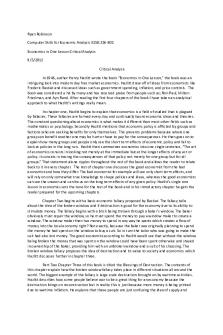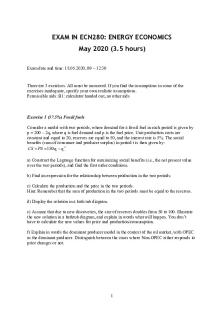Economics in one lesson PDF

| Title | Economics in one lesson |
|---|---|
| Course | StuDocu Summary Library EN |
| Institution | StuDocu University |
| Pages | 2 |
| File Size | 43.8 KB |
| File Type | |
| Total Downloads | 52 |
| Total Views | 162 |
Summary
Download Economics in one lesson PDF
Description
Ryan Robinson Computer Skills for Economic Analysis 3250:226-801 Economics in One Lesson Critical Analysis 9/5/2012 Critical Analysis In 1946, author Henry Hazlitt wrote the book “Economics in One Lesson,” the book was an intriguing look into modern day free market economics. Hazlitt drew off of ideas from economists like Frederic Bastiat and discussed ideas such as government spending, inflation, and price controls. The book was considered a hit by many and has received praise from people such as; Ron Paul, Milton Friedman, and Ayn Rand. After reading the first four chapters of the book I have taken an analytical approach to what Hazlitt’s writings really mean. In chapter one, Hazlitt begins to explain that economics is a field of studied that is plagued by fallacies. These fallacies are formed every day and continually haunt economic ideas and theories. The constant questioning about economics is what makes it different than most other fields such as mathematics or psychology. Secondly Hazlitt mentions that economic policy is afflicted by groups and factions who are seeking benefits for only themselves. This presents problems because where one group can benefit another one may be hurt or have to pay for the consequences. He then goes on to explain how many groups and people only see the short term effects of economic policy and fail to look at policies in the long run. Hazlitt then summarizes economics into one single sentence, “The art of economics consists in looking not merely at the immediate but at the longer effects of any act or policy; it consists in tracing the consequences of that policy not merely for one group but for all groups.” That statement alone ripples throughout the rest of the book and allows the reader to relate back to it in every chapter. The rest of chapter one discusses the good economist from the bad economist and how they differ. The bad economist for example will see only short term effects, and will rely on only somewhat true knowledge to shape policies and ideas, whereas the good economists can see the unseen and can focus on the long term effects of any given policy. Hazlitt’s single one lesson in economics sets the tone for the rest of the book and in his introductory chapter he gets the reader prepared for the upcoming chapters. Chapter Two begins with a basic economic fallacy proposed by Bastiat. The fallacy talks about the idea of the broken window and if destruction is good for the economy due to its ability to stimulate money. The fallacy begins with a brick being thrown through a baker’s window. The baker obviously must repair the window, so he must spend the money to pay a window maker to create a window. The window maker then has money to spend in any way he wants which creates a flow of money into the local economy right? Not exactly, because the baker was originally planning to spend the money he had spent on the window to buy a suit. So in turn the tailor who was going to make the suit had also lost money. The good economist according to Hazlitt would see that without the window being broken the money that was spent on the window could have been spent otherwise and stayed in ownership of the baker, providing him with an unbroken window and a suit of his choosing. The broken window fallacy proposes the idea of destruction and its value to society and economics which Hazlitt discusses further in chapter three. Part Two Chapter Three of this book is titled the Blessings of Destruction. The contents of this chapter explain how the broken window fallacy takes place in different situations all around the world. The biggest example of the fallacy is large scale destruction brought on by wartime activities. Hazlitt describes how some people believe war to be a great thing for an economy because the destruction brings on reconstruction but in reality this is just because more money is being printed due to wartime inflation. He explains that these people are just confusing the idea of supply and
demand and how they are, “merely two sides of the same coin.” War does not produce any accumulation of money but instead uses it on reconstruction when it could have been used for different demands in the first place. In summation this chapter provides a real life example of the broken window fallacy and it brings up a important economic issues regarding the day and age when this book was written which was 1946, just a year after World War II when most of Europe was razed to the ground. Chapter Four of the book discusses the idea of what is unseen in the good economist’s mind, the chapter is titled “Public Works Means Taxation.” This chapter really digs deep into the idea of government spending and if it is wasteful or not. In Hazlitt’s mind he again attributes what is unseen, saying that the public work projects that hire and then pay employees with taxpayer money do not construct a public work project that is needed but one that is “invented” or “created.” This means the project was not necessary and in terms of the secondary consequences a bridge that cost one million dollars took one million dollars out of the taxpayer’s hands which in terms took one million dollars out of private expenditures. Essentially Hazlitt states that the taxation of the people prevents things that could have come into existence rather than the government funded “inventions.” In summation Henry Hazlitt’s book, “Economics in One Lesson,” is one of those classic literary pieces due to its relevance in modern times. The book provides valuable teachings about the world of economics that can all be related back to one vital sentence, “The art of economics consists in looking not merely at the immediate but at the longer effects of any act or policy; it consists in tracing the consequences of that policy not merely for one group but for all groups.” In the four chapters that I have discussed I believe that one can find that their meaning can resonate in the perilous times of today’s economy. The broken window fallacy does raise a lot of questions and I agree with Henry Hazlitt that destruction is not necessary to stimulate growth of an economy. I feel as if Hazlitt strongly disagreed with much of Franklin Roosevelt’s policies during WWII since much of Roosevelt’s policies involved ideas like public works projects, and wartime production and inflation. That being said, I think this book is a very interesting take on history from an economic stand point and how one economist (Hazlitt) viewed the world going on around him. In conclusion, I believe the one lesson taught by Mr. Hazlitt is a lesson about economics that is to be remembered for the ages....
Similar Free PDFs

Economics in one lesson
- 2 Pages

Economics in one lesson
- 33 Pages

Lesson 1 Intro TO Economics
- 5 Pages

Science lesson one - Prof. Maur
- 10 Pages

Motion in One Dimension
- 6 Pages

Economics lesson 1 - Lecture notes 1
- 17 Pages

Lesson Plan in Euphemisms
- 1 Pages

Lesson Plan in Filipino
- 256 Pages

Lesson Plan in Entrepreneurship
- 4 Pages

Lesson Plan in English
- 5 Pages

EXAM IN ECN280: ENERGY ECONOMICS
- 3 Pages
Popular Institutions
- Tinajero National High School - Annex
- Politeknik Caltex Riau
- Yokohama City University
- SGT University
- University of Al-Qadisiyah
- Divine Word College of Vigan
- Techniek College Rotterdam
- Universidade de Santiago
- Universiti Teknologi MARA Cawangan Johor Kampus Pasir Gudang
- Poltekkes Kemenkes Yogyakarta
- Baguio City National High School
- Colegio san marcos
- preparatoria uno
- Centro de Bachillerato Tecnológico Industrial y de Servicios No. 107
- Dalian Maritime University
- Quang Trung Secondary School
- Colegio Tecnológico en Informática
- Corporación Regional de Educación Superior
- Grupo CEDVA
- Dar Al Uloom University
- Centro de Estudios Preuniversitarios de la Universidad Nacional de Ingeniería
- 上智大学
- Aakash International School, Nuna Majara
- San Felipe Neri Catholic School
- Kang Chiao International School - New Taipei City
- Misamis Occidental National High School
- Institución Educativa Escuela Normal Juan Ladrilleros
- Kolehiyo ng Pantukan
- Batanes State College
- Instituto Continental
- Sekolah Menengah Kejuruan Kesehatan Kaltara (Tarakan)
- Colegio de La Inmaculada Concepcion - Cebu




